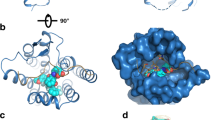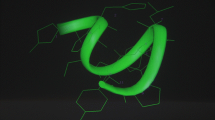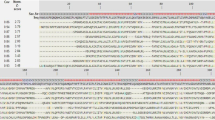Abstract
Leuprolide [dLeu6, NHEt10]GnRH, a potent gonadotropin-releasing hormone (GnRH) agonist, is used in a wide variety of hormone-related diseases like cancer and endometriosis. In this report, the conformational behaviour of Leuprolide and its linear synthetic analogues, namely [Tyr5(OMe), dLeu6, Aze9, NHEt10]GnRH (1) and [Tyr5(OMe), dLeu6, NHEt10]GnRH (2) have been studied in DMSO and H2O solutions by means of 2D nuclear magnetic resonance (NMR) experiments and detailed molecular dynamics (MD) simulations. The aim was to identify the conformational requirements of GnRH analogues for agonistic activity. This approach is of value as no crystallographic data are available for the GnRH receptor (G protein-coupled receptor, GPCR). The NOE data indicate the existence of a β-turn type I in the 2–5 segments of Leuprolide and its linear analogues in the case of using DMSO-d6 as solvent, whereas a β-turn type II in the 3–6 segments is indicated using D2O as solvent. The final structures fulfil the conformational requirements that are known, in the literature, to play a significant role in receptor recognition and activation. Finally, the linear analogues (1) and (2) are biologically active when tested against the human breast cancer cell line, MCF-7.






Similar content being viewed by others
Abbreviations
- GnRH:
-
Gonadotropin releasing hormone
- NMR:
-
Nuclear magnetic resonance
- MD:
-
Molecular dynamics
References
Discovery Studio v2.0 (2005), Molecular Modeling Systems, supplied by Accelrys Software Inc., Cerius2 Modeling Environment, Release 4.8. Accelrys Software Inc, San Diego
Ayub M, Levell MJ (1990) Suppression of plasma androgens by the antiandrogen flutamide in prostatic cancer patients treated with Zoladex, a GnRH analogue. Clin Endocrinol 32:329–339
Brooks BR, Bruccoleri RE, Olafson BD, States DJ, Swaminathan S, Karplus M (1983) CHARMM: a program for macromolecular energy, minimization, and dynamics calculations. J Comp Chem 4:187–217
Chen J, Wonpil I, Brooks CL (2006) Balancing solvation and intramolecular interactions: toward a consistent generalized born force field. J Am Chem Soc 128(11):3373–3728
Conn PM, Crowley WF (1991) Gonadotropin-releasing hormone and its analogues. N Engl J Med 324(2):93–103
Coy DH, Coy EJ, Schally AV (1975) Research Methods in Neurochemistry. In: Marks N, Rodnight R (eds), Plenum, New York, pp 393–404
Hazum E, Conn PM (1988) Molecular mechanism of gonadotropin releasing hormone (GnRH) action, I: the GnRH receptor. Endocr Rev 9:379–386
Kaufmann M, Jonat W, Kleeberg U, Eiermann W, Janicke F, Hilfrich J, Kreienberg R, Albrecht M, Weitzel HK, Schmid H, Strunz P, Schachner-Wunschmann E, Bastert G, Maass H (1989) Goserelin, a depot gonadotropin-releasing hormone agonist in the treatment of pre-menopausal patients with metastatic breast cancer. J Clin Oncol 7:1113–1119
Keramida M, Matsoukas J, Panagiotopoulos D, Alexopoulos K, Matsoukas E, Cladas J, Tzigounis V, Cardamakis E, Maia H, Pati D, Habibi H (1996) Design and synthesis of a gonadotropin-releasing hormone (GnRH) analogue, [Tyr(OMe)5, d-Glu6, Aze9]GnRH: receptor binding, gonadotropin release and ovulation studies. Lett Pept Sci 3:257
Keramida M, Tselios T, Mantzourani E, Papazisis K, Mavromoustakos T, Klaussen C, Agelis G, Deraos S, Friligou I, Habibi H, Matsoukas J (2006). Design, synthesis, and molecular modeling of a novel amide-linked cyclic GnRH analogue cyclo(4-9)[Lys4,d-Trp6,Glu9]GnRH: stimulation of gonadotropin gene expression. J Med Chem 49(1):105–110
Laskowski R, McArtur M, Moss D, Thornton J (1993) PROCHECK: a program to check the stereochemical quality of protein structures. J Appl Cryst 26:283–291
Mantzourani ED, Tselios TV, Golič Grdadolnik S, Platts JA, Brancale A, Deraos G, Matsoukas JM, Mavromoustakos TM (2006) Comparison of proposed putative active conformations of myelin basic protein epitope 87–99 linear altered peptide ligands by spectroscopic and modelling studies: the role of positions 91 and 96 in T-cell receptor activation. J Med Chem 49:6683–6691
Mantzourani ED, Platts JA, Brancale A, Mavromoustakos TM, Tselios TV (2007) Molecular dynamics at the receptor level of immunodominant myelin basic protein epitope 87–99 implicated in multiple sclerosis and its antagonists altered peptide ligands: triggering of immune response. J Mol Graph Model 26:471–481
Mantzourani ED, Blokar K, Tselios TV, Matsoukas JM, Platts JA, Mavromoustakos TM, Grdadolnik SG (2008) A combined NMR and molecular dynamics simulation study to determine the conformational properties of agonists and antagonists against experimental autoimmune encephalomyelitis. Bioorg Med Chem 16:2171–2182
Matsoukas J, Keramida M, Panagiotopoulos D, Mavromoustakos T, Maia HLS, Bigam G, Pati D, Habibi HR, Moore GJ (1997) Structure elucidation and conformational analysis of gonadotropin releasing hormone and its novel synthetic analogue [Tyr(OMe)5, d-Lys6, Aze9NHEt]GnRH: the importance of aromatic clustering in the receptor binding activity. Eur J Med Chem 32:927–940
Matsoukas J, Apostolopoulos V, Kalbacher H, Papini AM, Tselios T, Chatzantoni K, Biagioli T, Lolli F, Deraos S, Papathanassopoulos P, Troganis A, Mantzourani E, Mavromoustakos T, Mouzaki A (2005) Design and synthesis of a novel potent myelin basic protein epitope 87–99 cyclic analogue: enhanced stability and biological properties of mimics render them a potentially new class of immunomodulators. J Med Chem 48:1470–1480
Meyer JD, Manning MC, Vander DG (2002) Velde, characterization of the solution conformations of leuprolide acetate. J Peptide Res 60:159–168
Millar RP, King JA (1983) Synthesis, luteinizing hormone-releasing activity, and receptor binding of chicken hypothalamic luteinizing hormone-releasing hormone. Endocrinology 113:1364–1369
Millar RP, King JA (1988) Evolution of gonadotropin-releasing hormone: multiple usage of a peptide. N Physiol Sci 3:49–53
Millar RP, Milton RC, Follett BK, King JA (1986) Receptor binding and gonadotropin-releasing activity of a novel chicken gonadotropin-releasing hormone ([His5, Trp7, Tyr8]GnRH) and a d-Arg6 analogue. Endocrinology 119:224–231
Millar RP, Flanagan CA, Milton RC, King JA (1989) Chimeric analogues of vertebrate gonadotropin-releasing hormones comprising substitutions of the variant amino acids in positions 5, 7, and 8 Characterization of requirements for receptor binding and gonadotropin release in mammalian and avian pituitary gonadotropes. J Biol Chem 264:21007–21013
Momany FA (1976) Conformational energy analysis of the molecule, luteinizing hormone-releasing hormone, 2: tetrapeptide and decapeptide analogues. J Am Chem Soc 98:2990–3000
Momany FA (1978) Conformational analysis of the molecule luteinizing hormone-releasing hormone, 3: Analogue inhibitors and antagonists. J Med Chem 21:63–68
Morikis D, Roy M, Sahu A, Troganis A, Jennings PA, Tsokos GC, Lambris JD (2002) The structural basis of compstatin activity examined by structure-function-based design of peptide analogs and NMR. J Biol Chem 277:14942–14953
Muske LE (1993) Evolution of gonadotropin-releasing hormone (GnRH) neuronal systems. Brain Behav Evol 42:215–230
Nicklaus MC, Wang S, Driscoll JS, Milne GW (1995) Conformational changes of small molecules binding to proteins. Bioorg Med Chem 3:411
Ramachandran GN, Sasisekharan V (1968) Conformations of polypeptides and proteins. Adv Protein Chem 23:283–437
Ramakrishhan C, Ramachandran GN (1965) Stereochemical criteria for polypeptide and protein chain conformations, II: allowed conformations for a pair of peptide units. Biophys J 5:909–933
Ryckaert JP, Ciccotti G, Berendsen HJC (1977) Numerical integration of the cartesian equations of motion of a system with constraints: molecular dynamics of n-alkanes. J Comput Phys 23:327–341
Scambia G, Panici PB, Baiocchi G, Perrone L, Gaggini C, Iacobelli S, Mancuso S (1988) Growth inhibitory effect of LH-RH analogs on human breast cancer cells. Anticancer Res 8:187–190
Sica G, Iacopino F, Marini L, Robustelli della Cuna G (1992) Antiproliferative effect of leuprorelin acetate, alone or combined with tamoxifen or medroxyprogesterone acetate, on human breast cancer cell lines. Clin Ther 14:87–96
Söderhäll JA, Polymeropoulos EE, Pqulini K, Gunther E, Kuhne R (2005) Antagonist and agonist binding models of the human gonadotropin-releasing hormone receptor. Biochem Biophys Res Commun 333:568–582
Stephenson SL, Kenny AJ (1988) The metabolism of neuropeptides: hydrolysis of peptides by the phosphoramidon-insensitive rat kidney enzyme endopeptidase 2 and by rat microvillar membranes. Biochem J 255:45–51
Tselios T, Daliani I, Probert L, Deraos S, Matsoukas E, Roy S, Pires J, Moore G, Matsoukas J (2000a) Treatment of experimental allergic encephalomyelitis (EAE) induced by guinea pig myelin basic protein epitope 72–85 with a human MBP(87–99) analogue and effects of cyclic peptides. Bioorg Med Chem 8:1903–1909
Tselios T, Daliani I, Deraos S, Thymianou S, Matsoukas E, Troganis A, Gerothanassis I, Mouzaki A, Mavromoustakos T, Probert L, Matsoukas J (2000b) Treatment of experimental allergic encephalomyelitis (EAE) by a rationally designed cyclic analogue of myelin basic protein (MBP) epitope 72–85. Bioorg Med Chem Lett 10:2713–2717
Vignon F, Bouton MM, Rochefort H (1987) Antiestrogens inhibit the mitogenic effect of growth factors on breast cancer cells in the total absence of estrogens. Biochem Biophys Res Commun 146(3):1502–1508
Vilchez-Martinez LA, Coy DH, Coy EJ, Schally AV, Arimura A (1975) Anti-luteinizing hormone (LH)-releasing activity of several analogues of LH-releasing hormone. Fertil Steril 26:554–559
Wuthrich R (1986) NMR of proteins and nucleic acids. Wiley, New York
Acknowledgments
Despina Laimou is thankful for being supported by University of Patras (Grand K. Karatheodoris).
Author information
Authors and Affiliations
Corresponding authors
Electronic supplementary material
Below is the link to the electronic supplementary material.
Rights and permissions
About this article
Cite this article
Laimou, D.K., Katsara, M., Matsoukas, MT.I. et al. Structural elucidation of Leuprolide and its analogues in solution: insight into their bioactive conformation. Amino Acids 39, 1147–1160 (2010). https://doi.org/10.1007/s00726-010-0549-8
Received:
Accepted:
Published:
Issue Date:
DOI: https://doi.org/10.1007/s00726-010-0549-8




